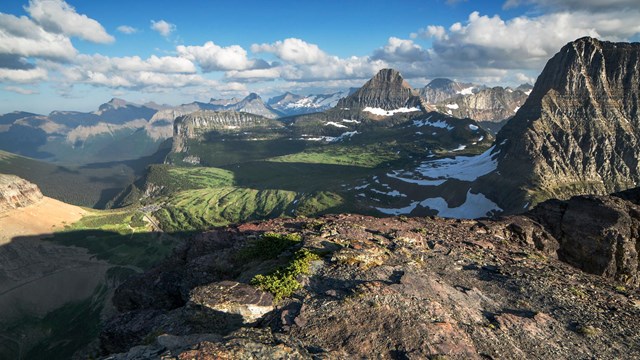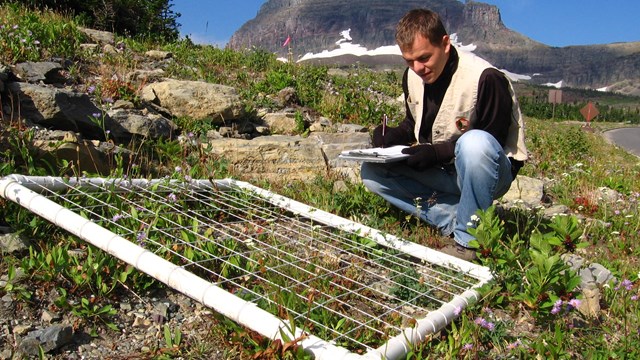|
Glacier National Park has a proud legacy of research and scientific accomplishment dating back to the period prior to World War II. Although a formal research program did not exist in the park until the mid 1960s many research projects and investigative surveys were carried out during the first half of the twentieth century by independent and academic investigators. The application of knowledge gained through science is essential for effective park management.

Research Learning Center
Research Learning Centers have been developed to promote research and scientific understanding in our national parks. 
Research Permits
Those interested in conducting research in Glacier need to acquire a permit. Park Researchers The primary research partner for the National Park Service is the U.S. Geological Survey (USGS). Scientists at the Glacier Field Station are involved with interdisciplinary, regional and multi-agency programs. Many of these are long-term strategic investigations that address high visibility national priorities. Examples include a multi-year regional grizzly bear investigation, studies of sensitive fish populations, post-fire burn assessments, and one of the nation's premiere Global Climate Change research programs. These scientists are administratively attached to the USGS Northern Rocky Mountain Science Center in Bozeman, Montana. Check out the Science & Learning video page for in-depth information on research projects. Recent Science Initiatives in the National Park Service In the early 2000s the NPS launched several new science initiatives as part of the Natural Resource Challenge program, a Service-wide effort aimed at bolstering science and resource management throughout the national parks. A key feature of this initiative is a network of Cooperative Ecosystem Studies Units (CESU's). These units were created to facilitate park science and provide technical assistance to resource managers within designated biogeographic regions. A prominent feature of the CESU program is establishment of formal linkages with a national network of colleges, universities and non-governmental research organizations. The NPS has placed full-time Research Coordinators at the universities hosting CESU's. Glacier National Park was fortunate to be among the first Parks to benefit from this initiative through establishment of the Rocky Mountains CESU located at the University of Montana in Missoula. Dr. Brendan Moynahan, the National Park Service Research Coordinator and Science Advisor at this unit, facilitates research, technical assistance and outreach programs between affiliated universities and parks throughout the United States with an emphasis on units in the Rocky Mountain cluster. A further boost to park-based science was provided through the inauguration of a Service-wide comprehensive Inventory and Monitoring Program. The biological inventory phase of this initiative was implemented in 1999 to secure basic descriptive information about natural resources occurring throughout the nationwide system of national parks, monuments and historic sites. Glacier National Park received funds to begin this work in 2001. The second phase of the program involves long-term ecological monitoring known as "Vital Signs Monitoring". Glacier National Park is part of the Rocky Mountain Inventory and Monitoring Network headed by Mike Britten. Another initiative established under the Natural Resource Challenge program is creation of a national network of learning centers. National Park Service Research Learning Centers are designed to increase the effectiveness and communication of research and science results in national parks through facilitating the use of parks for scientific inquiry, supporting science-informed decision making, communicating the relevance of and providing access to knowledge gained through scientific research, and promoting science literacy and resource stewardship. An important theme underlying the Learning Center concept is multidisciplinary collaboration and the involvement of natural resource agencies among all levels of government, including regional Native American tribes and educational institutions. Implementation of this initiative varies widely among different parks. Glacier National Park converted two Mission 66 houses in the headquarters area at West Glacier to office space and temporary facilities for visiting scientists. The Glacier National Park unit, aptly named the Crown of the Continent Research Learning Center (CCRLC), serves Waterton-Glacier International Peace Park, Grant-Kohrs National Historic Ranch, and Little Bighorn National Battlefield. The Director of the CCRLC is Tara Carolin. If you have questions about Nature or Science & Research in Glacier, or any other general questions about the park, please e-mail us. A park naturalist will respond or forward it to the most appropriate park office for response. |
Last updated: September 17, 2019
